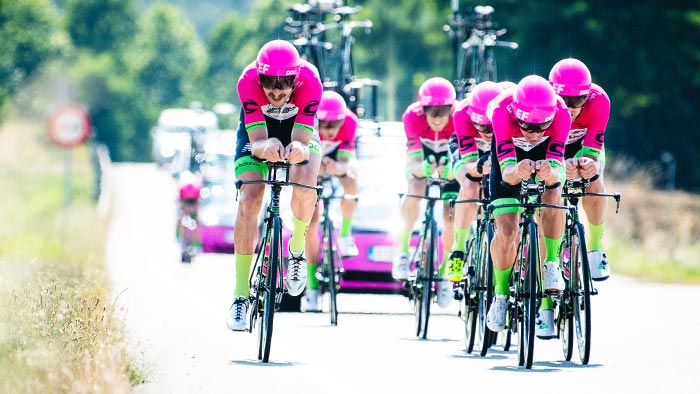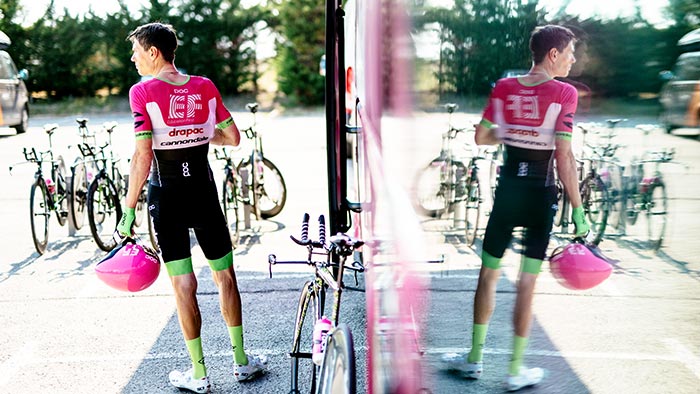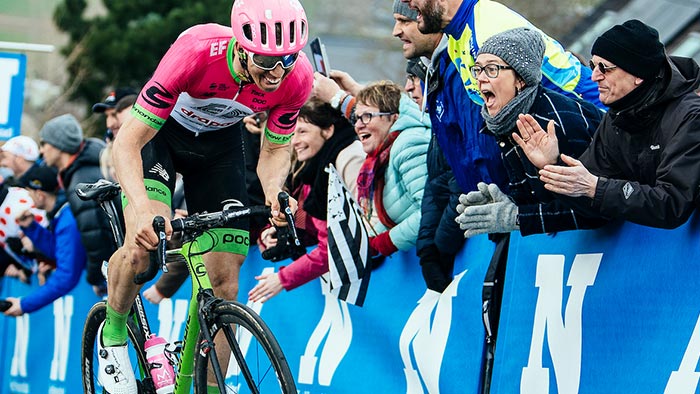Tim Kennaugh is the performance manager for team EF Education First-Drapac p/b Cannondale. The following interview has been edited lightly for length.
LT: What has Uran’s leadup to the Tour de France been like?
Tim Kennaugh: So this year Uran’s actually done a similar amount of race days pre-tour as last year. Last year he did 33 days, and after he’s finished Slovenia this year he’ll have done 27 days
So pretty similar buildup, obviously what he did last year worked really well.
LT: Are you trying to recreate what he did last year?
TK: Pretty much. He has his own external coach, so I don’t actually coach Rigo, but from his training and his plans he looks to be doing a similar buildup, maybe slightly more TTT work.
LT: What does that look like?
TK: A good session I like to do for TTT work is behind the motorbike. You basically replicate a TTT, so you do turns alongside the bike for anywhere between 10 to 30 seconds, then you drop back behind the bike as if you’re resting like you would in the paceline. I think that’s really good because it’s very specific to the race, and it’s easier on the guys’ heads, because they’ve got something to sort of race against instead of just looking at their power meters.
LT: How fast is the bike going?
TK: Anywhere from 45 to 55k per hour really, depending on the terrain.
LT: So if you were just a normal rider at home, how could you replicate that? Find a friend with a bike? Chase a car?
TK: I think it’s actually illegal in a lot of countries, so I can’t suggest people do it.
LT: What, motorpacing?
TK: Motorpacing is illegal in Spain, yeah, and in England.
LT: So, uh… how do you pull it off?
TK: I mean, it’s one of those things where you’re not allowed to do it, but no one really stops you.
LT: And then if you get caught I guess you could just pretend you don’t know each other…?
TK: Yeah, he’s just following me around out here!
LT: So you probably can’t tell us too much about team selection, right?
TK: Obviously having the TTT and the cobbles does effect team selection, because it’s going to be vital that Uran limits his losses, or doesn’t lose any time in those stages. Fortunately, the characteristics of a good classics rider, or someone who’s good on the cobbles, normally lend themselves to being good TTT riders, which is useful.
LT: What in particular?
TK: Their power output, and their anaerobic capacity to be able to go fast on the flats basically. It’s generally more suited to the bigger guys than the skinny climbers. So we’ve been encouraging the guys on the long list to put more TTT work into their training schedule in the build up to the tour, which they’ve been doing. We’ve held a few training camps, and got a pre-tour camp coming up (TTT specific), and we also did one in January training camp. So that’s been useful for sure.
LT: How is the team atmosphere after last year’s Tour de Framce?
TK: As far as the team’s atmosphere around Uran’s breakthrough Tour last year? Well I wasn’t actually on the team last year so I can’t compare, but everyone always seems to ride well when Uran’s on the team. He’s a very calm, very relaxed leader, so it’s very good for team spirit and the team environment.
LT: That’s pretty amazing that the riders aren’t stressing. Are they really not feeling the pressure?
TK: No. He would be like the most relaxed one on the team, even when he’s up there on the GC. But obviously the riders put pressure on themselves, they want to perform. And I think, when you know you’ve got a rider on the team who can win the big races, it definitely brings a bit more out of the riders, and helps get that extra 1%, that motivation.
LT: What specific metrics or tools from Training Peaks do you use most?
TK: Yeah, I like the PMC quite a lot, because that’s a good overview of riders fitness, and freshness and fatigue, and gives us a good indicator of where their form’s at. So I like to use that. Also what can be useful is their peak watts per kilo over certain durations. In the last month of training, for example, if we know you’ve got a race where there’s a climb that lasts 7 minutes, and it’s a key moment of the race in the last 20k or something like that, then you can really compare the riders over that duration, then you can make good team selection and tactical choices.
But obviously people still have to be able to race a bike, not just put out good numbers.
LT: Do you have any good workouts to share?
TK: As far as training sessions go, that’s a pretty difficult one to answer because it depends what you’re training for, what your goals are, and what phase of training you’re in. But if a rider was looking to improve their threshold, or do better at tie trials, or go on longer sustained climbs, A good session is 2×20 minutes. The first 20 minutes at 98% of FTP around 95 RPRM, 10 minutes easy, then the second block of 20 minutes at a 100-105% FTP 95 RPM. You can obviously build up to that, drop it to 15 minutes then build to 20. It’s a hard session on the head, but it definitely works.
LT: What stage are you most excited for?
TK: I’m really excited for that 65 kilometer stage, the really mountainous one, because it’s just gonna be epic. And they’re gridding the start line, so the GC positions will be on the front. It’ll be racing right from the gun, it’ll be really interesting to see how that’s raced, also the time limit—it’s going to be such a fast race on the front, it’ll be interesting to see if the sprinters get dropped on the first climb.
LT: Will you be with the riders during the Tour?
TK: Not sure what I’m gonna do there yet, it’s so busy there.
LT: What’s it like managing their training and then just watching the Tour de France play out?
TK: Oh good question. I don’t know actually. I’ll be worried at certain points in the race, the TTT for example, because that’s a key moment, and it’s something that we’ve struggled on in the past. And we really want to perform there, so you get a bit nervous and there’s things like that. And obviously you’ve got your fingers crossed on the cobbled stages that we don’t puncture at the wrong time. That’s the main thing, I’d guess.
LT: So more like the stuff you can’t control?
TK: Yeah exactly.
LT: It must be cool to watch these guys do what they’ve been training for.
TK: Yeah, especially as you build up relationships and get to know a few of them them. It’s only my first year here so I don’t know a lot of the guys super well, but the few you build a relationship with you definitely watch the race in a different light.
LT: Is there someone you’re gonna be really rooting for or is it like your kids, where you can’t choose favorites?
TK: I think you can’t choose favorites!
LT: This is your first year with EF Education First-Drapac p/b Cannondale. Who were you with before?
TK: A British team called JLT Condor, I was with them for five years. This was something I’ve been working for for a while to be honest. It has always been my goal, so when the opportunity came I jumped at it.
LT: So this is your first Tour too!? Come on, you’ve gotta be nervous!
TK: Yeah, I’m just trying to kinda step back and do what I can do and not worry too much, you know what I mean? otherwise you’re just tired all the time. You can’t worry about it can you?
LT: Well that’s super exciting, I hope it goes well for you!
TK: Cheers, fingers crossed!
LT: Is there any other wisdom or nerdyness you’d like to share about training?
TK: I think just do the simple things, right? Everyone’s trying to look for the next big thing, the 1%. But is your diet good? Are you consistent with your training? Do you rest? Just the basics take you a really long way. Not everyone has them nailed down before they’re looking for the super workout or the special diet. The basics are diet, consistency, and recovery (so, not getting sick.)
And ride slow—I think a lot of people get caught up in just doing lots of work in zone 3 and 4, riding really hard all the time. There are so many adaptations that come from riding in zone 2. It really works to just keep a really long zone 2 ride in your week, for sure. Even as you get into the season, definitely keep a few maintenance rides just to maintain your condition.
Find out how the other teams train, and see files from the 2018 Tour de France here!







